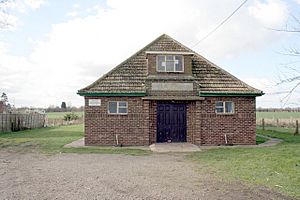Twenty, Lincolnshire facts for kids
Quick facts for kids Twenty |
|
|---|---|
 The Village Hall, Twenty |
|
| OS grid reference | TF153207 |
| • London | 90 mi (140 km) S |
| District |
|
| Shire county | |
| Region | |
| Country | England |
| Sovereign state | United Kingdom |
| Post town | BOURNE |
| Postcode district | PE10 |
| Dialling code | 01778 |
| Police | Lincolnshire |
| Fire | Lincolnshire |
| Ambulance | East Midlands |
| EU Parliament | East Midlands |
Twenty is a small village located in Lincolnshire, England. It's part of the South Kesteven area. You can find Twenty about 3 miles (5 km) east of Bourne and 5 miles (8 km) west of Spalding.
Where is Twenty Located?
Twenty is found right on the A151 road. This road might have been built a very long time ago, perhaps as a Roman road or a Norman causeway. A causeway is a raised road or path, often built over wet ground.
Today, the A151 road is known for the very deep drainage dyke that runs along its side. A dyke is like a ditch or channel that helps move water away. Close to Twenty are places like Guthram Gowt and West Pinchbeck. The River Glen flows just south of the village.
How Many People Live in Twenty?
It's tricky to say exactly how many people live only in Twenty. The numbers for the village are usually grouped with nearby areas. These include Dyke, South Fen, and a part of Spalding Road outside Bourne. Together, these areas have about 495 people, with Dyke being the largest part of that group.
How Does Twenty Manage Water?
The land around Twenty is part of a special area managed by the Black Sluice Internal Drainage Board. A drainage board is a group that looks after the water levels in a specific area. Their job is to make sure the land doesn't get too wet, especially in places that are low-lying.
This board takes care of a small electric pumping station near the crossroads in Twenty. It's called the Twenty Pumping Station. Pumping stations use powerful pumps to move water from lower areas to higher areas, helping to keep the land dry and safe for farming and living.



